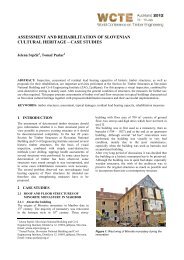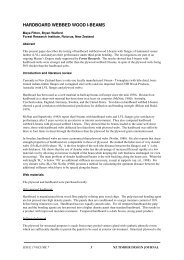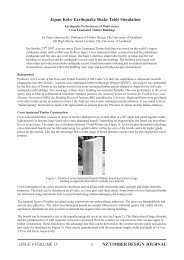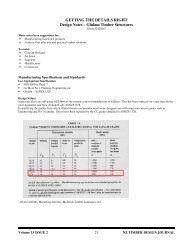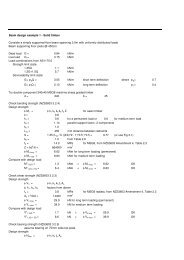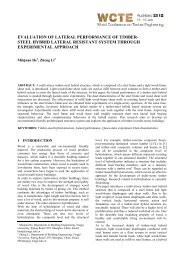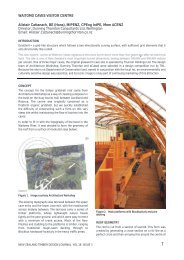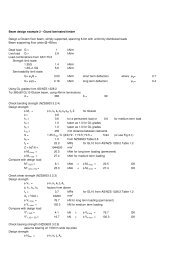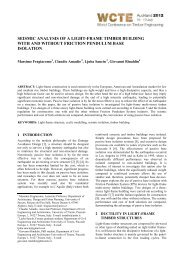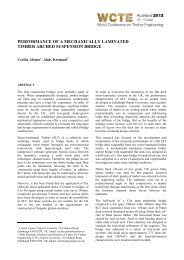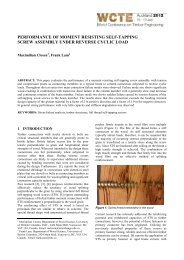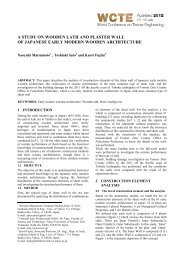00694 Pouyan Zarnani - Timber Design Society
00694 Pouyan Zarnani - Timber Design Society
00694 Pouyan Zarnani - Timber Design Society
You also want an ePaper? Increase the reach of your titles
YUMPU automatically turns print PDFs into web optimized ePapers that Google loves.
2.5 EFFECTIVE WOOD THICKNESS<br />
2.5.1 BRITTLE FAILURE<br />
In current tests on LVL and glulam, the average<br />
thickness of the failed block, t block , in the majority of the<br />
brittle failures was observed around 0.85L p . This<br />
thickness corresponds to the elastic deformation of the<br />
rivets since there were no observed plastic deflections.<br />
For brittle failure modes, the effective wood thickness<br />
(Eq. 16) is determined from the elastic deformation of<br />
the rivet modelled as a beam on an elasto-plastic<br />
foundation (Fig. 5). The rivet is supported by springs<br />
with bilinear response that simulate the local nonlinear<br />
embedding behaviour of the timber surrounding it. For<br />
more details regarding the model refer to <strong>Zarnani</strong> and<br />
Quenneville [8].<br />
Rivet<br />
flexural axis<br />
k h<br />
Embedding<br />
stiffness<br />
Figure 5: Spring model of elastic deformation of rivet as<br />
a beam on an elasto-plastic foundation<br />
0.95L p , for L p equals to 28.5 mm<br />
t ef,e ~ 0.85L p , for L p equals to 53.5 mm (16)<br />
0.75L p , for L p equals to 78.5 mm<br />
2.5.2 MIXED FAILURE<br />
Wood effective thickness<br />
w(x)<br />
For some connection groups, considerable decrease of<br />
t block combined to a distortion of rivets was visible. This<br />
failure mode is defined as the mixed mode since the<br />
wood fails with some deflection of the rivets before they<br />
reach complete yielding. In these groups, t block<br />
corresponded to the effective wood thickness, t ef ,<br />
depending on the governing failure mode of the rivets<br />
(Fig. 6).<br />
Mode I m Mode III m Mode IV<br />
Figure 6: Effective thickness based on the rivet<br />
embedded length in different failure modes<br />
x<br />
w<br />
Rotationally fixed<br />
Rivet head<br />
t ef can be derived using Equation 17 based on the<br />
Johansen’s yield theory [9] which is the foundation for<br />
the EYM prediction formulas in Eurocode 5 [5]. The<br />
proposed prediction for the wood strength showed good<br />
agreement with observed values of t block for these groups.<br />
t ef,y =<br />
f h<br />
L p<br />
t ef<br />
2<br />
L p<br />
f<br />
P r<br />
M<br />
f<br />
2<br />
y, l Lp<br />
d<br />
h,0<br />
l<br />
h,0<br />
y,<br />
l<br />
d<br />
l<br />
2<br />
f h<br />
M <br />
L p<br />
t ef<br />
P r<br />
M y<br />
o<br />
P<br />
f h<br />
M y<br />
Mode I m<br />
Mode III m<br />
Mode IV<br />
L p<br />
t ef<br />
P r<br />
(17)<br />
M y<br />
d l is the rivet cross-section dimension bearing on the<br />
wood parallel-to-grain, (equal to 3.2 mm); ƒ h,0 is the<br />
embedment strength of the wood which can be<br />
determined as a function of d l and the density of the<br />
wood [10]; and M y,l is the parallel-to-grain moment<br />
capacity of the rivet, equal to 30000 Nmm [6].<br />
2.6 PROPOSED PROCEDURE<br />
Based on the observation that the effective wood<br />
thickness differs in brittle and mixed failure modes<br />
which affect the wood strength, the following procedure<br />
(Fig. 7) is suggested to determine the load carrying<br />
capacity of the riveted connection for the possible brittle,<br />
ductile and mixed failure modes. In this paper, the rivet<br />
strength and its yielding mode is based on experimental<br />
results which also can be predicted by a consistent yield<br />
model proposed by <strong>Zarnani</strong> and Quenneville [10].<br />
Assume t block = t ef,e corresponding to rivet elastic<br />
deformation to predict wood strength P w<br />
from Eq. 13 and compare with rivet yielding strength P r<br />
If P w < P r<br />
No<br />
If P w ≥ P r<br />
No<br />
P u = P w<br />
(Mixed failure)<br />
Figure 7: Proposed algorithm for different possible brittle,<br />
ductile and mixed failure modes<br />
3 EXPERIMENTAL PROGRAM<br />
3.1 SPECIMENS<br />
Yes<br />
Assume t block =t ef,y corresponding to<br />
rivet yielding mode to predict P w<br />
Yes<br />
Load carrying capacity of<br />
connection P u = P w<br />
(Brittle failure)<br />
P u = P r<br />
(Ductile failure)<br />
The laboratory tests were set up to evaluate the effect of<br />
bottom, edge and end distances on connection strength<br />
and to force and observe the possible connection wood<br />
modes of failure. Specimens were manufactured from<br />
New Zealand Radiata Pine LVL grade 10 and glulam<br />
with grade of 8. The tests series were divided into 26<br />
groups for LVL (Table 1) and 6 groups for glulam<br />
(Table 2). 3 replicates were tested for each group of<br />
specimens for LVL and 4 replicates for glulam. The<br />
parameters for connection geometries (Fig. 4) used<br />
varied from 4 to 8 for N R and N C ; from 15 to 25 mm for<br />
S q and 25 to 50 mm for S p ; L p from 28.5 to 78.5 mm<br />
(with rivet lengths L r of 40, 65 and 90 mm); d z from<br />
0.1X b to 1.1X b ; d e from 0.2X l to 1.9X l and d a from 50 to<br />
125 mm. The specimens had riveted plates on both faces<br />
of timber, making a symmetric connection that better<br />
simulates real applications. The steel side plates were 8.4



